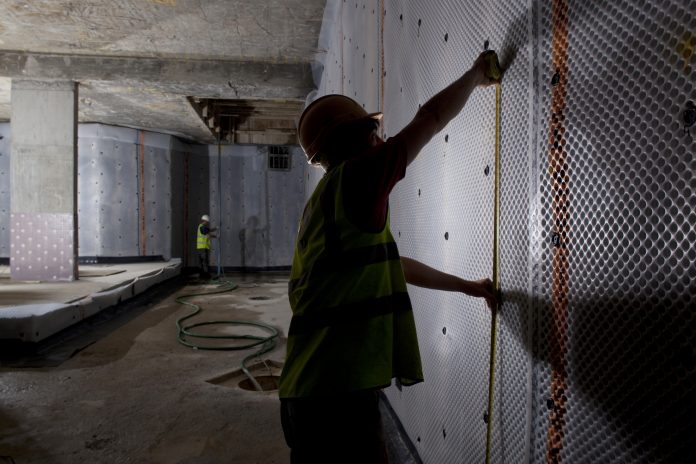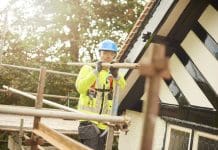Basement conversions are not just for the super-rich looking to add a new swimming pool – they are an increasingly popular way to add space in the home. In this article, James Berry of the Property Care Association looks at the importance of Building Regulations and supporting Approved Documents covering underground structures
Rising land values and a lack of space has meant the popularity in utilising the space beneath our feet has skyrocketed. The “iceberg” basement is now perceived as the latest must-have of the super-rich, typically containing swimming pools, gyms and cinemas but some of the more unconventional examples contain art galleries, gun stores and panic rooms to name a few. While not every basement is the “iceberg” basement, most are much more humble Victorian basements which have been converted for additional space.
Their popularity and desirability are on the increase. A study in 2018 by Newcastle University’s Global Urban Research Unit found that 4,650 basements were granted planning permission in some of the capital’s most affluent neighbourhoods between 2008 and the end of 2017. This study only covered the basements granted planning consent under existing properties and not those of new builds, showing the increasing popularity of utilising underground space.
Despite their increasing popularity, there is an inherent extra complexity when considering underground structures. This article looks at the importance of Building Regulations and supporting Approved Documents, which provide practical guidance on potential ways to achieve compliance in line with the regulations in England. It goes without saying that we could never cover all the relevant Building Regulations in this short article and it is in no way intended to be a comprehensive guide to the Building Regulations, but it will provide a brief overview of some of these key Approved Documents that are applicable during basement conversions in residential dwellings.
One thing we won’t consider in this article is the protection of underground structures from ground water, which must always be considered if making into habitable space. For this the reader should be familiar with BS 8102 Code of Practice for Protection of Below Ground Structures Against Water from the Ground. This document is the waterproofer’s bible and designing to the principles outlined in this document will help reduce the risk of ground water ingress into an underground structure. However, this article centres around the Building Regulations which support the provision of a dry environment below an existing structure. More details on the 10 steps to a successful waterproofing project can be found here.
While numbers are increasing there is certainly an argument that basements are not universally popular. The media is often all too happy to portray the surge in the popularity of basements in a bad light and when it goes wrong it tends to grab the headlines. How do you make sure you get it right? By making sure you follow the rules within the Building Regulations and British standards.
When do Building Regulations become applicable?
If adding a room for residential purposes then the Building Regulations will become applicable. Exceptions may apply depending on the use of the building, for example plant rooms not visited by people. However, in a residential setting and when converting a damp existing cellar into a habitable space, they will be applicable. If unsure, you should always consult a building control body, who will provide advice as to when the regulations apply (via either the local authority or an approved inspector).
A practical list of the meaning of building work as defined under Regulation 3 of the Building Regulations 2010 can be found here.
Responsibility for ensuring that the work complies with all applicable requirements falls to those that carry out the building work – designers, installers and the building owners. It is common practice that the building contractor will liaise with the building control body to confirm the timings of their inspections.
Let’s look at the applicable Approved Documents in more detail.
Approved Document B – Fire Safety in Dwelling houses
Covers precautionary measures necessary to provide safety from fires for building occupants, persons in the vicinity of buildings and firefighters. Since the tragic events in west London on 14 June 2017, there has been a huge amount of focus on fire safety and Building Regulations. Consequently, Part B was last revised in 2019 but it is unlikely the scrutiny will end there.
The Ministry of Housing, Communities & Local Government has launched a consultation under s.14(3) of the Building Act 1984 seeking views on proposals of potential amendments to the Building Regulations 2010 regarding the ban on the use of combustible materials in and on the external walls of buildings.
This consultation seeks views on potential amendments to the ban of the use of combustible materials in and on external walls of buildings, to include changes to:
- Building types covered.
- Height threshold.
- List of exemptions, attachments such as blinds, shutters and awnings.
- To specifically ban the use of metal composite panels in and on the external walls of buildings.
You can access the consultation here.
Why is this review particularly relevant in the context of basement conversions? Well, it lists “insulation and water proofing materials used below ground level” as one of the few exceptions. It would appear that during the course of the review, they have appreciated the particular complications with underground structures and the necessity of certain materials to prove a dry environment.
But back to Part B and the effect that this document will have on basement conversions will be dependent on the intended use. Basements being designed to habitable grade should have one of the following:
- a) An emergency escape window or external door providing escape from the basement to ground floor level, ensuring any such opening well may need to be guarded to stop people falling into the well.
- b) A protected stairway leading from the basement to a final exit.
In addition, Approved Document B may influence the choice of internal linings to prevent internal fire spread. In particular, the ceiling areas within the basement may need to be upgraded to be fire resistant.
Approved Document H – Drainage and Waste Disposal
One, if not the most common form of waterproofing existing basements in the UK, is the use of a cavity drainage membrane (CDM or Type C). Rather than work on the premise of ensuring the structure is completely watertight it acts as a water management system with the structure, providing primary resistance to the passage of water. This system then typically relies on a sump and pump system to discharge the water. The discharge of water from a Type C waterproofing system is too often an afterthought but is essential for its long-term success and must always be done so in accordance with Approved Document H.
Not only is this Approved Document H applicable in relation to any drainage of Type C System, but also any land drains that may be used within the waterproofing system.
Approved Document L1b – Conservation of Fuel and Power in existing dwellings
This document sets out the requirements of the building fabric to prevent heat loss and may influence the requirements of insulation to the ceiling, walls and floors within the basement conversion. In addition, for habitable spaces where appropriate ventilation, de-humidification or air conditioning are required, this document sets out the requirements to prevent energy loss. Most insulation manufacturers provide U-value calculations to show compliance with current Building Regulations and best practice.
Approved Document F – Means of Ventilation
Basements by their very nature will have reduced rates of air exchange and in basements which are habitable, greater emphasis is placed on the need for the provision of adequate ventilation. Unfortunately, basement conversions which later suffer from mould growth and damp as a result of little, or no, regard for ventilation are not uncommon. For basements with a large permanent opening, ventilation should be classed as part of the whole dwelling. However, properties with an isolated basement may require special consideration and might need to be considered a separate entity to the remainder of the property.
A consultation version of Approved Document F was published in October 2019. While the draft version proposes an entire section dedicated to existing buildings, it was empty. While it should be applauded that more consideration has been given to ventilation in existing buildings this should be extended to ensure it address the difficulty of the issues within basements.
Approved Document E – Resistance to the Passage of Sound
Walls between domestic dwellings are required to have a certain resistance to the passage of sound. This Approved Document sets out the acceptable limits and may also be applicable for deciding the make up between floors of the same building – this can be especially applicable when converting basements that have not previously been used for habitable space. Compliance with Robust Detailing, as referred to in Part E, may also be acceptable in new houses and flats.
Approved Document P – Electrical Safety
We have already described how the use of cavity drainage membrane is one of the most common methods of waterproofing an existing basement. We have also indicated that the success of these systems is reliant on their ability to discharge any water ingress via mechanical pumps. The cost of failure of the pumps is normally catastrophic and therefore it is essential that they are installed correctly. This document will be applicable for connecting pumping systems and any subsequent electrical wiring. These works should always be undertaken by suitably qualified persons.
Note: Power points, cables, light switches, pipes and any other services must be remounted in front of the membrane in Type C systems.
Successful basement projects
This could never be a comprehensive guide to all the considerations on a basement conversion project, but it gives an indication to some of the many elements that should be borne in mind. The success of any basement conversion is attention to detail. Not just the elements that prevent water ingress, but all the many elements that support this. Below ground structures are inherently high risk and the cost of failure is high, but the potential and the results they provide can be spectacular.
James Berry
Technical manager
Property Care Association
+44 (0)1480 400 000















